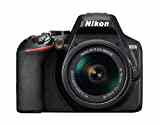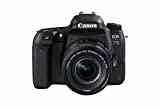DSLR cameras are a melting pot of modern and traditional technologies. Despite all the cutting-edge tech within, their design hasn’t changed dramatically since the days of film cameras, and the single lens reflex mechanism itself harks back to 1884. It's this marriage of old and new that allows SLRs to flatter even the most modest of photographic talents.
There's a good reason why some things haven't changed, though. The SLR mechanism might have its origins in the 1800s, but for those of us who still prefer viewfinders to digital displays, its ability to bounce light from the lens through a series of mirrors and direct into your eye still gives you the most direct view of the shot you’re about to take.
Whether you have £400 or £4,000 to spend, our guide below explains what features you need and pinpoints the best DSLRs you can buy.
READ NEXT: The best tripods to buy from £40
How to pick the best DSLR camera for you
There’s not much wrong with entry-level SLRs, but these are the various reasons why you might want to splash out on a pricier model.
Doesn’t spending more deliver better-quality photos?
Not necessarily. There’s not much to separate a £400 from a £1,000 SLR for image quality. The big jump comes when you move from cropped-sensor to full-frame SLRs.
A cropped SLR sensor measures around 24 x 15mm, which is equivalent to 23 smartphone camera sensors arranged in a grid. That’s why their image quality is so much better. Full-frame sensors are around 36 x 24mm, which is 58 times bigger than a phone’s sensor. These start at around £1,300.
The choice of lens can make more of a difference than choosing between a cropped and full-frame sensor. Even if you can afford to go full-frame, you will often get better results by going for a cropped-sensor camera and having more to spend on lenses.
So why else should I spend more money?
There are other reasons why cropped-sensor SLRs range from £400 to £1,500, and full-frame SLRs vary from £1,300 to £5,000.
Pricier models have bigger viewfinders, which enhances the experience of using the camera. Lots of buttons and dials make it quicker to adjust settings without taking your eye from the viewfinder. Pricier cameras tend to be bigger, which means they’re more comfortable to hold and have room for longer-lasting batteries. Paying more also gives you faster performance and more sophisticated autofocus and video.
What cameras are best for landscape photography?
Landscape photography is relatively undemanding for the camera. A high megapixel rating is useful for big prints but a high-quality lens is probably more important. 24 megapixels is more than enough for sharp A3 prints.
What cameras are best for portraits?
A blurred background can really flatter portrait shots. The full frame helps to achieve this, but a wide-aperture lens is a cheaper route to the same result. Go for both for the strongest effect. Having a camera with lots of autofocus points makes it easier to focus precisely on the subject’s eyes.
What cameras are best for sports and wildlife?
Fast burst speed and large buffer let you capture lots of shots, and sophisticated autofocus with subject tracking keeps moving subjects in focus. You’ll also need a telephoto lens — these start at around £250, but expect to pay at least £1,000 for one that matches the quality of a full-frame SLR.
What do I need if I want to shoot video?
All modern SLRs shoot video but some do a better job than others. 1080p resolution is standard but some support 4K recording — a feature that’s worth having. Autofocus performance varies: at best it’s smooth and responsive, at worst, like a bull in a china shop. An articulated touchscreen is useful for video, letting you position the camera freely and move the autofocus point while recording.
The best DSLRs to buy
1. Nikon D3500: The best DSLR under £500
Price: £379 | Buy now from Amazon
The Nikon D3500 exploded onto the scene with just the right amount of tweaks to the outgoing D3400. It’s a little lighter and offers an impressive battery life, at up to 1,500 shots per full charge. That, plus its low weight (415g), should be enough to interest a vast number of travel photographers.
Nikon has wisely left much of the camera’s innards untouched. It still has a 24.1-megapixel sensor, and the 11-point autofocus system is unchanged. Of the two, the autofocus system is the more limiting, but only those hankering for tricky wildlife or sports shots should worry.
Image quality is excellent. Noise is well controlled to ISO 800, although that doesn’t mean images were unusable beyond that, and Nikon’s outstanding imaging heritage is writ large within the D3500’s superb results. That excellence is there in the camera’s movie mode as well: it’s not a camera for die-hard videographers, but basic image quality is excellent.
Key specs – Sensor: 24.2 megapixels; Focus: 11-point, 1x cross-type (centre) autofocus; Video modes: 720p at 59.94, 50fps; 1080p at 59.94, 50, 29.97, 25, 23.976fps; Shutter speed range: 30s-1/4,000th; Max continuous speed: 5fps; ISO range: 100-25,600; Memory card slot: SD, SDHC, SDXC; Lens mount: Nikon F mount; Display: 3in, 921k-pixel monitor; Connectivity: USB, mini-HDMI, Bluetooth; Battery life: 1,500 shots; Dimensions: 124 x 70 x 97mm (WDH); Weight: 415g without lens



2. Canon EOS 77D: The best mid-range DSLR
Price: £789 | Buy now from Amazon
The Canon EOS 700D, 750D and this, the 77D, were all released at roughly the same time, which means they all share similar features and choosing between any of them is tough.
Look a little closer, though, and the 77D begins to stand out. Its 24.2-megapixel sensor is covered by 45 cross-type autofocus points, making it a capable performer when it comes to moving subjects. It’s let down slightly by its continuous frame rate, which at just 6fps could start to feel a little constraining.
Otherwise, this camera ticks a lot of boxes. Luxurious touches abound, such as the 3in, vari-angle touchscreen monitor, and wireless options that include NFC and Bluetooth as well as Wi-Fi. Movie-makers might feel a little let down by the lack of 4K, but everything else is present and correct. If your budget is less than a grand, this camera won’t disappoint.
Key specs – Sensor: 24.2 megapixels; Focus: 45-point (45x cross-type) autofocus; Video modes: 720p at 25, 29.97, 50, 59.94fps; 1080p at 23.98, 25, 29.97, 50, 59.94fps; Shutter speed range: 30s-1/4,000th; Max continuous speed: 6fps; ISO range: 100-51,200; Memory card slot: SD, SDHC, SDXC; Lens mount: Canon EF-S mount; Display: 3in, 1,040k-pixel vari-angle touchscreen monitor; Connectivity: USB, mini-HDMI, 3.5mm audio-in, Wi-Fi, Bluetooth, NFC; Battery life: 600 shots; Dimensions: 131 x 76 x 100mm (WDH); Weight: 540g without lens

3. Nikon D500: The best DSLR for sports and wildlife photography
Price: £1,699 body-only | Buy now from Amazon
The Nikon D500 might cost more than some full-frame DSLRs, but this APS-C model is fast, feature-packed and ready for action. Its 153-point autofocus sensor almost fills the frame and excels at tracking fast-moving subjects. Burst shooting is at 10fps, and the buffer is good for 82 JPEGs or 34 RAW shots.
There are also masses of buttons, dials and sockets, a large articulated touchscreen and big viewfinder. Video is recorded at 1080p or 4K, and while video autofocus could be better, the D500 records relatively static subjects superbly.
Image quality is as good as we’ve seen from a cropped-sensor DSLR, and not far behind full-frame quality. If you want fast performance and don’t want to shell out £5,000 on something like the Nikon D5, this is the camera to buy.
Read our full review here
Key specs – Sensor: 21.5 megapixels; Focus: 153-point (99 cross-type) autofocus; Video modes: 720p at 50, 60fps; 1080p at 24, 25, 30, 50, 60fps; 4K at 24, 25, 30fps; Shutter speed range: 30s-1/8,000th; Max continuous speed: 10fps; ISO range: 100-51,200; Memory card slot: SD, SDHC, SDXC, XQD; Lens mount: Nikon F mount; Display: 3.2in, 2,259-pixel vari-angle touchscreen monitor; Connectivity: USB, mini-HDMI, 3.5mm audio-in, Wi-Fi, Bluetooth, NFC; Battery life: 1,240 shots; Dimensions: 147 x 81 x 115mm (WDH); Weight: 860g without lens
4. Nikon D850: The future of full-frame cameras
Price: £2,628 body-only | Buy now from Amazon
A 45.7-megapixel full-frame sensor, up to 9fps burst shooting, EXPEED 5 processor, 4K UHD video, ISO 32 to 102,400 sensitivity, Wi-Fi, Bluetooth and SnapBridge connectivity, a 3.2in tilting touchscreen, dual XQD/SD card slots, a new battery claiming nearly 2,000 exposures on a single charge – and more. Safe to say, the D850 is a great example of what happens when a manufacturer throws caution to the wind and builds a camera for only the most rarefied of budgets.
All of this would be for naught if the camera didn’t deliver outstanding images, but image quality is top-notch. Detail and colour balance were excellently detected and controlled while shooting at high ISOs rendered surprisingly useable images. Autofocus is superb as well and videographers are well catered for, with the headline specifications being full-frame 4K Ultra HD at 30p or 1080p Full HD at up to 60fps.
It doesn’t come cheap, but if you’re in the market for a well-built high-specification, high-resolution DSLR that packs all of the latest tech, it really is the best choice.
Read our full review here
Key specs – Sensor: 45.7 megapixels; Focus: 153-point (99 cross-type) autofocus; Video modes: 720p at 50, 60fps; 1080p at 24, 25, 30, 50, 60, 100, 120fps; 4K at 24,25,30fps; Shutter speed range: 30s-1/8,000th; Max continuous speed: 9fps; ISO range: 32-102,400; Memory card slot: SD, SDHC, SDXC, XQD; Lens mount: Nikon F mount; Display: 3.2in, 2,359-pixel vari-angle touchscreen monitor; Connectivity: USB, mini-HDMI, 3.5mm audio-in, Wi-Fi, Bluetooth; Battery life: 1,840 shots; Dimensions: 146 x 79 x 124mm (WDH); Weight: 1kg without lens
5. Canon EOS 5D Mark IV: Incredible full-frame image quality
Price: £2,599 body-only | Buy now from Amazon
Canon’s 5D series of cameras has a superb track record and the Mark IV is the best of the bunch. The big changes this time around are an upgraded 61-point autofocus sensor, 7fps continuous shooting and 4K video capture. Videos also benefit from Canon’s Dual Pixel tech for slick autofocus and a touchscreen to move the autofocus point while recording. Image quality lives up to highest expectations, with its 30-megapixel photos exhibiting less noise than those of the 22-megapixel 5D Mark III. Dual Pixel also improves live view autofocus performance.
As with previous 5D models, ergonomics are top notch, with elegant controls and lots of information overlaid onto the big viewfinder. It’s not cheap, but this is a camera that performs exceptionally across the board.
Read our full review here
Key specs – Sensor: 30.4 megapixels, full frame; Focus: 61-point (41 cross-type) autofocus; Video modes: 720p at 100, 119.9fps; 1080p at 23.98, 25, 29.97, 50, 59.94fps; 4K at 23.98, 24, 25, 29.97fps; Shutter speed range: 30s-1/8,000th; Max continuous speed: 7fps; ISO range: 50-102,400; Memory card slot: SD, SDHC, SDXC, CompactFlash; Lens mount: Canon EF mount; Display: 3in, 1,620-pixel touchscreen monitor; Connectivity: USB, mini-HDMI, 3.5mm audio-in, Wi-Fi, Bluetooth; GPS: Yes; Battery life: 900 shots; Dimensions: 151 x 116 x 76mm (WDH); Weight: 800g without lens
6. Canon EOS 200D: The best DSLR for beginners
Price: £519 | Buy now from Amazon
If you’re taking your first steps into the world of DSLRs, the EOS 200D is an excellent choice. It’s compact and reasonably priced, yet boasts a fully-articulated touchscreen and takes great photos. That means you can expect flattering colours, with plenty of detail and nicely controlled noise. And shooting is a breeze, thanks to Canon’s Dual Pixel sensor technology.
It’s easy to share your snaps, too. Built-in Wi-Fi, Bluetooth and NFC allow the camera to connect directly to smartphones and printers, and a companion app lets you shoot remotely, while controlling settings such as exposure, white balance and drive mode from your phone.
Although the Canon EOS 200D isn’t the cheapest DSLR on the market, it’s a high-quality, user-friendly option that’s ideal for anyone making the transition from a smartphone or compact camera.
Read our full review here
Key specs – Sensor: 24.2 megapixels, APS-C; Focus: 9-point, 1x cross-type (centre) autofocus; Video modes: 720p at 25, 29.97, 50, 59.94fps; 1080p at 23.98, 25, 29.97, 50, 50.94fps; Shutter speed range: 30s-1/4,000th; Max continuous speed: 5fps; ISO range: 100-51,200; Memory card slot: SD, SDHC, SDXC; Lens mount: Canon EF-S mount; Display: 3in, 1,040k-pixel vari-angle monitor; Connectivity: USB, mini-HDMI, 3.5mm audio-in, Wi-Fi, Bluetooth, NFC; GPS: No; Battery life: 650 shots; Dimensions: 122 x 70 x 93mm (WDH); Weight: 453g without lens
The best DSLRs of the last generation: Last chance to buy
If you can't afford the latest and greatest, or you're looking to get a mid-range or high-end DSLR for a little less, it's well worth considering one of last year's models. Below you'll find our picks and links to our full reviews to help you make up your mind.
1. Nikon D3400: A brilliant budget DSLR that's worth snapping up
Price: Around £260 body only | Buy now from Wex
This DSLR delivers the goods where it counts and has a number of advantages over its main rival, the Canon EOS 1300D. It has a slightly bigger viewfinder, faster burst mode and longer battery life. Its 24-megapixel sensor captures more detail than the 1300D’s 18-megapixel sensor, and it also exhibits less image noise in low light. It beats the Canon for video quality, too, with crisper details in its 1080p footage, and smoother autofocus.
As with any DSLR at this price, there aren’t many single-function buttons and dials, so various functions require a trip to the menu. Its flash is relatively weak and its Bluetooth transfers to iOS and Android devices could be more reliable. Otherwise, though, this is a great all-rounder at a very attractive price. Make sure you get the VR version of the kit lens, which includes stabilisation to avoid blurry handheld shots.
Read our full review here
Buy now from Wex
2. Canon EOS 70D: A stunning mid-range DSLR for the money
Price: Around £400 body-only | Buy now from Wex
When the Canon EOS 80D showed up, we weren’t bowled over. The problem wasn’t so much that there was anything wrong with it, but rather that it only made small improvements over this, the brilliant EOS 70D.
The 70D is no longer listed on Canon’s website but it’s still available at some retailers at competitive prices. It’s a big step up from the Canon EOS 750D and 760D, with a bigger viewfinder, more buttons and dials, bigger battery and faster 7fps burst mode, plus Canon’s Dual Pixel tech that delivers responsive, reliable autofocus for live view and video capture.
It’s beginning to show its age for noise levels at fast ISO speeds, but otherwise, this is a superb all-rounder and a bargain at current prices.
Buy now from Wex
